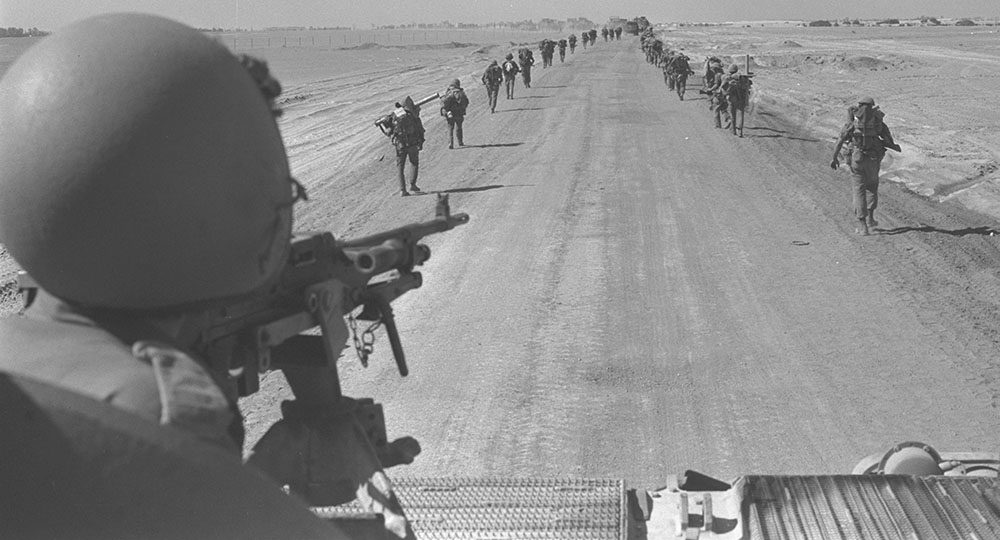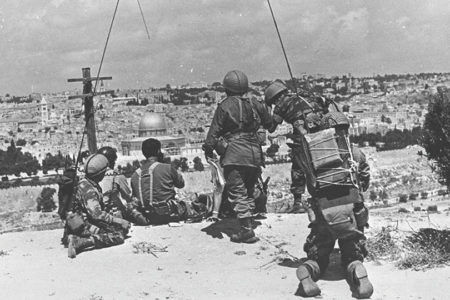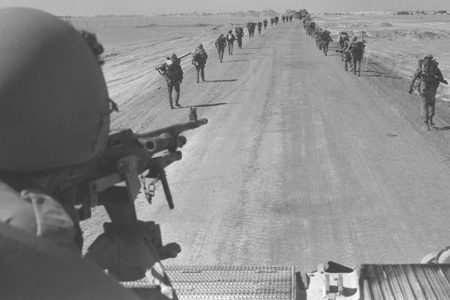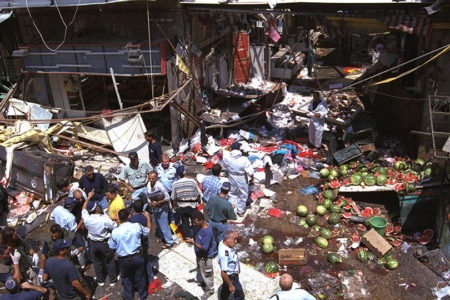The Yom Kippur War Oct/Nov 1997
A Nation Caught by Surprise
Prime Minister Golda Meir was worried. It was that same strange feeling she had back in 1967, on the eve of the Six-Day War. Reports had been coming in since May stating that Syrian and Egyptian troops were gathering on Israel’s northern and southern borders. The families of the Russian advisers in Syria were packing up and leaving in a hurry—another troubling sign. Yet the head of the Israeli intelligence service assured her that the present circumstance was not cause for alarm. The Chief of Staff and the Minister of Defense agreed. Still, Golda Meir was unable to sleep on the night of October 5, 1973. At 4 a.m., her telephone rang. Her worst fears were confirmed. Israel would be attacked! This particular Israeli/Arab war would be different from the others because the shock would linger for years.
October 6, 1973, was Yom Kippur. On this day a solemn quiet fills most Jewish households. The observant attend synagogue services to seek atonement for their sins. Others rest and spend the day in quiet, personal reflection. There are no excursions to the beaches or parks, no picnics or entertainment—only silence. It is the most sacred day on the Jewish calendar—and the Arabs knew it.
Since the end of the Six-Day War and the War of Attrition (1967, 1970), Syria and Egypt had plotted moves toward another major conflict with Israel. The ominous signs coming from the Arab world caused Golda Meir to call an emergency cabinet meeting. The issue was whether to strike first. In the past, Israel relied on its preemptive strike and fast-moving, offensive armor. Yet it was Moshe Dayan who argued that if Israel mobilized before a shot was fired, they would risk intense international criticism as the aggressor in this war. During their meeting, the military secretary burst into the room shouting that the shooting had started. Suddenly they heard the piercing wail of air-raid sirens. The Yom Kippur War had begun.
The history books call this war by various names. To Israel it is the Yom Kippur War. To the Arabs it is the War of Ramadan or simply the October War. Whatever the title, this conflict was started by the aggressive acts of Egypt and Syria in launching coordinated surprise attacks into the Sinai Peninsula and the Golan Heights.
Numerically superior in manpower and material, Egypt and Syria had Russian support and sophisticated Soviet weapons. Highly equipped and able to overwhelm Israel, they fortified their confidence with various myths. The enemy reasoned that they would have won the Six–Day War if only they had struck first, so this time they waited for a day when Israel would be caught off guard. They assumed that on October 6, Israel would be at its lowest state of preparedness. However, they were wrong about Israel’s vulnerability on Yom Kippur. On that day most Jewish people were at home or in synagogues, which made it easier to mobilize Israel’s reserve forces.
Another Arab myth was that they would have a spiritual advantage by launching their attack during Ramadan, Islam’s holy month of fasting ordained by the Koran so that its followers “may cultivate piety.” The Grand Sheikh in Cairo exhorted the beguiled with battle cries: “We are fighting for Allah, for Islam and for humanity.” “Allah promised us heaven if we fight in his name, so let us rush to the noble battlefield.”
The Arabs had a 20-to-1 edge over Israel in infantry forces and a 5-to-1 advantage in tanks. With this massive assault force, the enemy achieved a strategic and tactical advantage early in the war. Along the Suez Canal during the first two or three days of the war, only a thin line of about 436 brave young Israelis stood between the nation and disaster. In the first minute of the attack, the Egyptians launched a concentrated barrage of 10,500 Soviet-made shells on a handful of Israeli fortifications at the rate of 175 shells per second. Egyptian bombers then dropped their canisters of death, after which the first wave of 8,000 assault infantrymen threw themselves against the battered Israelis. An Egyptian commander later recounted how a lone Israeli tank fought off his infantry division for more than half an hour. This solitary tank inflicted heavy casualties on his troops. After repeated assaults, they finally overcame the tank. The Egyptian commander was amazed to find that all of the crew members had been killed with the exception of one badly wounded soldier, who had continued the fight. In tribute to these noble young men, Golda Meir later said, “They fought, and fell, like lions.”
After a horrendous tank battle along the entire southern front, the battle turned in favor of Israel. Ten days after the Egyptian onslaught on the east bank, the first wave of Israeli troops crossed the Canal on the west bank. Egyptian missile bases were destroyed, and Israeli war planes became masters of the skies over the Sinai. The United Nations Security Council, under pressure from the Soviet Union, demanded a cease-fire before Israel destroyed the Egyptian Third Army. Even Cairo was threatened. Still, in the end, the Israeli army, against tremendous odds, achieved a major victory over the armies of Anwar Sadat.
In the north, the Syrians had battered the Israeli forces with a massive air strike and artillery bombardment of the Golan Heights. Outnumbered and outgunned, the Israeli positions and installations were overrun, including the observation post on Mount Hermon. However, by midday Wednesday, almost four days after the attack, the pride of the Syrian army was broken by a brilliant Israeli counterattack that threatened even the city of Damascus.
As in the Sinai, individual heroism abounded. A young blond lieutenant, the son of Holocaust survivors, alone engaged Syrian tanks. He darted in and out among the hills at night, destroying one enemy tank after another. His tank was hit and set afire. Suffering burns on his arms and face, he flung himself off of his burning tank, jumped on another, and continued his war. By the time he was relieved because of wounds, he had single-handedly destroyed 60 Syrian tanks.
Within four days, the Israeli army recovered and chased the Syrians back to their starting line. One historian said, “The most modern arms and equipment that the Soviet Union had supplied to any foreign army dotted the undulating hills of the Golan Heights, testimony to one of the great tank victories in history against the most incredible odds, and to the indomitable spirit of the Israeli force.”
As God gradually turned the tide of the war in Israel’s favor, the international community felt compelled to rescue their oil-rich Arab clients. There was no concern as to who had started the war and who had lost. The important thing was to rescue the Arabs from the situation. The Soviet Union declared a red alert and was preparing to send in Russian paratroops. The United States responded with its own red alert. It was as close as the world had ever come to a global holocaust. The Soviets backed down.
Even before the shooting had stopped, the Arabs and their supporters were solacing themselves at the United Nations for the humiliation Israel had caused them. Sadly, it was the United States that pressured Israel to give in to the Arab demands. Golda Meir later wrote in her autobiography, “Once again there was the standard concern for the tender feelings of the Arab aggressors, rather than for those of the victims of Arab aggression, that we were urged to compromise in the name of ‘world peace.’ ” A cease-fire was ordered.
Israel achieved victory in this 17-day war, but it came at a great price. Israel reportedly had 2,523 casualties—about one-tenth of one percent of the population. Thousands more were wounded. The casualty estimates for Egypt and Syria were 16,000. Resentment and blame eventually caused Golda Meir to resign at the end of the war. She continued to remain a strong voice for peace in the Labor Party until her death in 1978.
The conflict gave Anwar Sadat enough credibility to risk negotiations with Israel. In 1978, Egypt and Israel signed the Camp David Accords, followed by a peace treaty in 1979. Sadat’s peace-making risk was rewarded by his assassination in 1981 by Islamic extremists.
Syria continues to view Israel as its avowed enemy. According to a 1996 report from the U.S. Congressional Task Team on Terrorism, Syria is “rattling the sabers,” along with Iran and Iraq, in anticipation of another war with Israel.
The Yom Kippur War was a near disaster for the 26-year-old modern State of Israel. But God sustained the young nation: “Many a time have they afflicted me from my youth; yet they have not prevailed against me” (Ps. 129:2). Let us hope that Israel has learned this truth.
Military historians point out that Israel was lulled into a false sense of security—overconfidence resulting from its swift victories in past wars. The Israelis saw themselves as invincible and their enemies inferior. At the same time, Israel put too much confidence in its ability to mobilize rapidly.
Another contributing factor to Israel’s near disaster in 1973 was its failure to appreciate the enemy’s determination to destroy them. Long before the attack took place, the enemy used the tactic of misinformation to disguise their true intentions, thus lulling Israel into a state of complacency. “I never believed that the enemy [Israel] could be led astray,” said Sadat’s Chief of Staff, General Shazli, after the war.
There is a lesson for Christians in Israel’s failure to be vigilant in the days before the Yom Kippur War.
Ephesians 6 speaks of putting on the full armor of God to stand against the enemy of our souls. We are not to be fooled into a state of complacency when everything appears to be going well. We are to stand vigilant, always guarding against Satan’s determination to destroy our lives and testimonies (1 Pet. 5:8).






